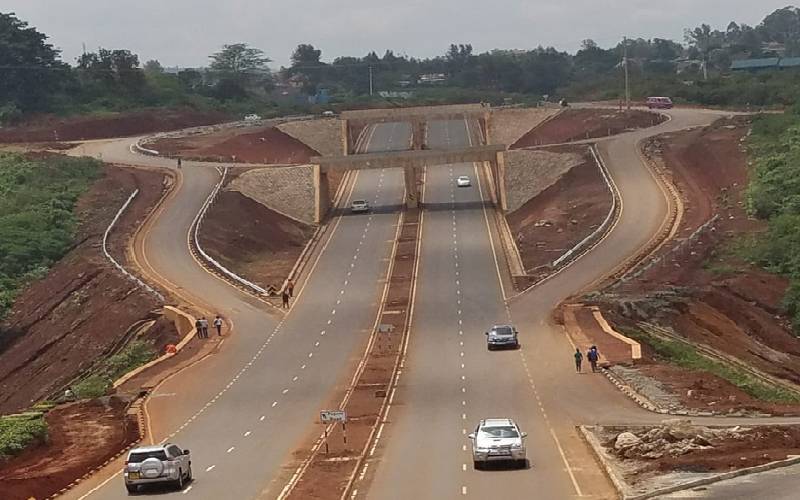 The new link road from Waiyaki Way to Red Hill Road in Nairobi provides a breathtaking view and backdoor route to the leafy suburbs beyond Westlands. Never mind that it has created a gridlock as it joins Waiyaki Way.
The new link road from Waiyaki Way to Red Hill Road in Nairobi provides a breathtaking view and backdoor route to the leafy suburbs beyond Westlands. Never mind that it has created a gridlock as it joins Waiyaki Way.
Lots of drivers want to get into James Gichuru Road or go towards Kangemi, and must ‘cut’ through to get into the outer lane then make a U-turn. Clearly an interchange here would make a big difference.
But this link road was built for the affluent, the car owners. I’ve not seen a matatu there yet. But within no time, tuktuks were in plenty and so were pedestrians. I doubt the road designers had anticipated such huge traffic on foot going by the narrowness of the walking lanes. When you drive there in the morning, you have to careful to avoid the pedestrians in the middle of the road.
Road designers often forget hustlers who own no cars, but move from one point to another using the shortest route possible, which happens to be bypasses or link roads. A drive along most roads indicates that our road designers built roads for cars not people. That amazes me. Kenya has about two million cars, meaning that a majority of Kenyans walk but are ignored in road designs.
I have seen a few roads with signs written, ‘No matatus allowed beyond this point’. Yet in these ‘restricted’ places, hustlers do a lot of work and must walk long distances.
Great road designers include lanes for walking, cycling and even space for idling. I keep alluding to our love for copying other countries’ systems. Anyone who’s driven through the US knows of rest stops on superhighways, where you can literally park your car, eat, go to the restroom (or toilet in hustlespeak) or even sleep in your car before driving on. Why didn’t we copy that when we were copying governors and senators? I’m hoping that the American firm building the new Nairobi-Mombasa road will put up such rest stops.
Needy passengers
No wonder along most highways you find matatus parked by the bushes for men and women to ‘drain’. Road designers seem to ignore our lives in totality, including our biological systems. My suspicion is that those facilities are there in the design stage, but are dispensed of during the implementation stage to cut corners.
Luckily, entrepreneurs know how to make money from such design shortcomings, including with mobile toilets. Maybe mobile toilets will soon be plying our highways, waiting to be stopped by needy passengers.
Designing roads, buildings, hospitals, schools for the lowliest members of society is a sign of progress. After all, the non-hustlers will take care of themselves. But we behave and act as if hustlers are a nuisance and dispensable. Yet, even the most advanced economies have their hustlers. These humble members of society play their role in turning the reluctant wheel of progress.
For instance, why are there no public toilets in the affluent parts of Nairobi’s CBD, like Koinange Street or Kenyatta Avenue? And why are toilets in most buildings often under lock and key? To keep out hustlers? Where else do you think we’ve ignored hustlers and their needs?
XN Iraki; [email protected]
 The Standard Group Plc is a multi-media organization with investments in media
platforms spanning newspaper print operations, television, radio broadcasting,
digital and online services. The Standard Group is recognized as a leading
multi-media house in Kenya with a key influence in matters of national and
international interest.
The Standard Group Plc is a multi-media organization with investments in media
platforms spanning newspaper print operations, television, radio broadcasting,
digital and online services. The Standard Group is recognized as a leading
multi-media house in Kenya with a key influence in matters of national and
international interest.
 The Standard Group Plc is a multi-media organization with investments in media
platforms spanning newspaper print operations, television, radio broadcasting,
digital and online services. The Standard Group is recognized as a leading
multi-media house in Kenya with a key influence in matters of national and
international interest.
The Standard Group Plc is a multi-media organization with investments in media
platforms spanning newspaper print operations, television, radio broadcasting,
digital and online services. The Standard Group is recognized as a leading
multi-media house in Kenya with a key influence in matters of national and
international interest.

 The new link road from Waiyaki Way to Red Hill Road in Nairobi provides a breathtaking view and backdoor route to the leafy suburbs beyond Westlands. Never mind that it has created a gridlock as it joins Waiyaki Way.
The new link road from Waiyaki Way to Red Hill Road in Nairobi provides a breathtaking view and backdoor route to the leafy suburbs beyond Westlands. Never mind that it has created a gridlock as it joins Waiyaki Way.







